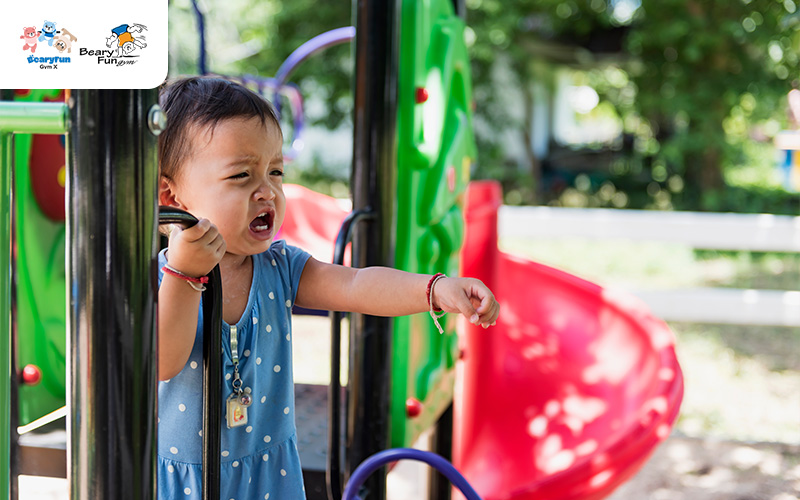Introduction
It’s perfectly natural for young children to feel uneasy or frightened when faced with height-related activities. These may include climbing a ladder, balancing on a beam, and peering down from a platform. Known as acrophobia, fear of heights can surface at any age. Its early signs often appear in childhood and are considered a normal part of developmental growth.
With the right support, this fear doesn’t have to hold children back. Gentle, age-appropriate exposure to heights—especially in safe, structured environments like preschool gyms—can help young ones gradually build courage, balance, and confidence.
In this article, we explore why fear of heights develops in young children and how early exposure through play-based movement can tackle the problem.
Key Takeaways:
- Why Is It Important to Address Fear of Heights Early in Childhood?
Early intervention helps prevent temporary fear of heights from becoming long-term anxiety. Supporting your child with structured, safe exposure during the toddler and preschool years lays the groundwork for emotional resilience and physical confidence.
- How Does Gradual Exposure in Preschool Gyms Help Reduce Anxiety?
Gentle, repeated exposure to low-height challenges in a supportive setting helps children desensitise their fear response. With each small success, their fear gives way to curiosity, self-assurance, and greater body control.
- What Makes Preschool Gyms Ideal for Building Confidence Around Heights?
Preschool gyms offer a uniquely safe and encouraging environment with padded surfaces, expert guidance, and child-led progression. Activities are designed to help children explore heights at their own pace while developing essential motor skills.
Understanding the Fear of Heights in Young Children
Why Are Young Children Afraid of Heights?
It might surprise some parents to see their toddler freeze on a playground ladder or hesitate at the top of a small slide. But in reality, fear of heights in young children is quite common. Understanding where it comes from can help parents and educators offer the right kind of support.
At the preschool stage, children are still learning how to move confidently through their environment. As their spatial awareness, balance, motor control, and other skills are still maturing, unfamiliar elevated spaces—no matter how small—can feel overwhelming or risky.
This fear is not necessarily irrational. From a child’s point of view, a short platform might feel like a skyscraper. Without full confidence in their ability to climb, jump, or balance, their instinct is often to freeze, cling, or avoid the situation altogether. In many cases, it turns into a protective response.
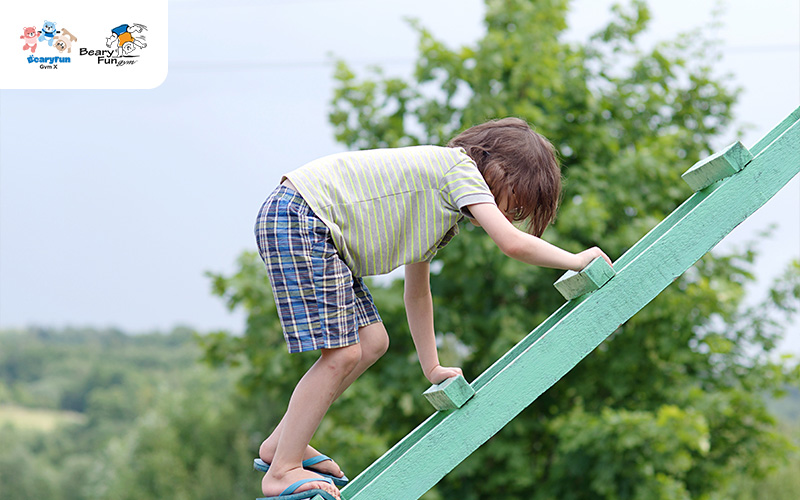
When Does It Typically Develop?
While general caution around heights can appear as early as toddlerhood, more intense or persistent fear tends to emerge in early to middle childhood. Commonly occurring before the age of 10, acrophobia may be triggered by a single negative experience or develop gradually through avoidance and anxiety.
The important thing to note is that early fears are not always cause for concern. Many children naturally outgrow them as their coordination improves and they gain confidence in their surroundings. However, if the fear is reinforced by stress, overprotection, or lack of exposure, it can solidify into a longer-term phobia.
By recognising that fear of heights is often rooted in physical development and emotional security, parents and caregivers can approach the situation with empathy and patience. The goal isn’t to push children too far or too fast, but to create a safe space where they can challenge themselves gradually.
Is Fear of Heights Learned or Inborn?
In the previous section, we explored how young children develop a fear of heights and why it’s a normal part of growing up. Now, we’ll learn whether the fear of heights is something children are born with, or is it shaped by their environment and experiences?
1. Learned Behaviour
Many fears—especially those that persist into later childhood—are the result of past experiences. For example, a child who has fallen from a climbing structure may begin to associate all elevated activities with the fear or pain of that moment. Over time, even being asked to walk across a low balance beam could trigger anxiety.
Interestingly, the experience doesn’t have to be first-hand. Observational learning significantly impacts how young children process risk. If they see another child fall, or even watch a fall in a cartoon, they may internalise that fear and apply it to similar real-life situations. In this sense, fear of heights can be learned, reinforced by negative associations and a lack of positive exposure.
2. Innate (Inborn) Response
On the other hand, some researchers argue that caution around heights is hardwired into the human brain. From an evolutionary perspective, avoiding heights would have served as a survival mechanism, keeping early humans safe from dangerous falls.
This theory is supported by studies using the “visual cliff” experiment. In these studies, infants are placed on a surface that appears to drop off, although it has been covered by clear, solid glass. Even without any prior experience of falling, many babies hesitate or avoid crawling over the “cliff,” suggesting an instinctive fear of falling.
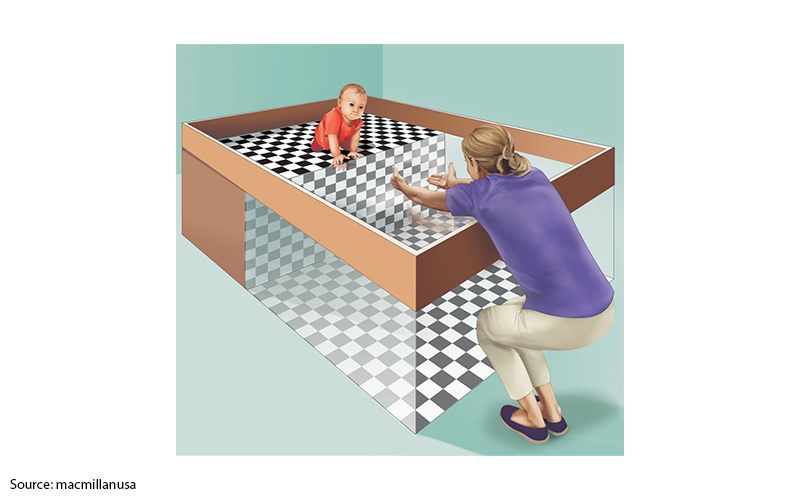
In other words, some level of height sensitivity may be biologically programmed. This goes to show that individual responses are influenced by genetics, temperament, and neurological development.
What Are the Signs Your Child May Be Struggling With Height Anxiety?
While a certain level of caution is natural, some children exhibit more intense and persistent fear of heights. Recognising the early signs of height anxiety can help parents and educators provide the right guidance before the fear becomes deeply ingrained.
Watch for these common signs that may suggest a fear of heights in your child:
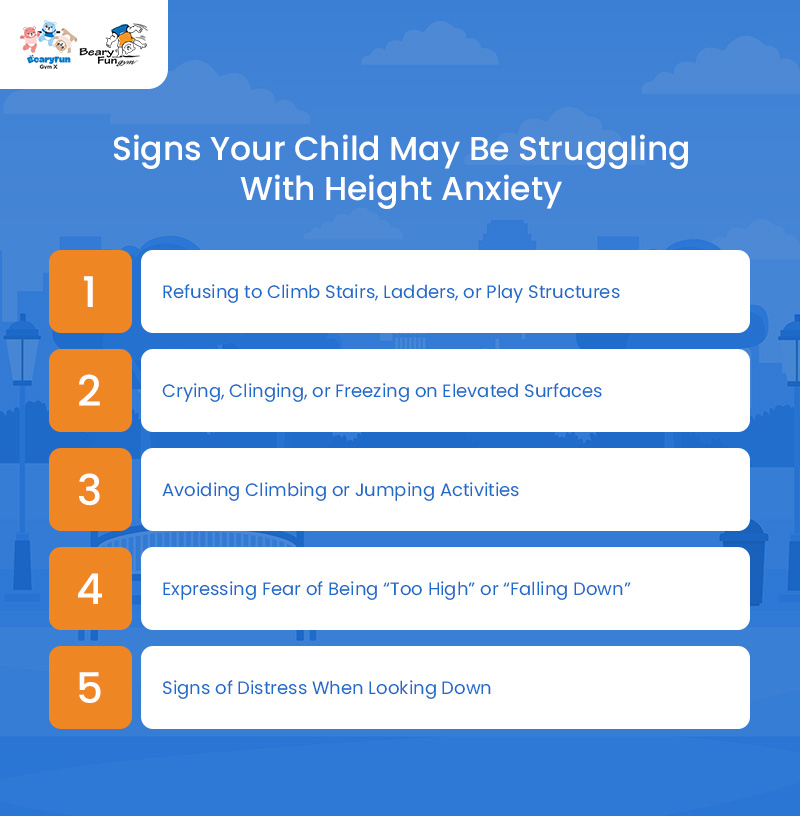
1. Refusing to Climb Stairs, Ladders, or Play Structures
Be aware if your child consistently avoids climbing stairs, jungle gyms, ladders, or slides—even if they are appropriate for their age. This could be a sign that height-related anxiety is holding them back.
2. Crying, Clinging, or Freezing on Elevated Surfaces
Children with height anxiety often show strong physical or emotional reactions when asked to stand on elevated surfaces. They may cry, cling tightly to a caregiver, or freeze in place, even if the platform is just a few inches off the ground. These behaviours are signs of fear and self-protection.
3. Avoiding Climbing or Jumping Activities
While every child has their preferences, frequent avoidance of any activity that involves climbing, jumping, or balancing could indicate discomfort with height. Instead of exploring or playing freely, they may stick to ground-level activities or become passive observers.
4. Expressing Fear of Being “Too High” or “Falling Down”
Verbal expressions such as “I’m scared I’ll fall,” or “This is too high for me,” reflect an internalised fear. These statements show that the child is not just cautious but is experiencing emotional distress linked to height.
5. Signs of Distress When Looking Down
Even without climbing, some children may feel anxious simply by looking down from an elevated spot, like a balcony, stage, or platform. Sweating, fidgeting, clinging, or backing away are all physical cues that their fear response has been triggered.
The Importance of Early Exposure: How Preschool Gymnastics Supports Fear Reduction
How Gradual Exposure Reduces Fear
Overcoming a fear of heights doesn’t happen overnight. Only with the right approach, children learn to face their fears and begin to enjoy height-related activities. One of the most effective methods for managing this kind of anxiety is gradual exposure.
Just like in exposure therapy used for treating phobias, the key is to introduce children to the source of their fear in a safe, structured, and low-pressure setting. By engaging in low-risk height activities early in life, children begin to build physical confidence and emotional resilience.
This gentle approach helps in several important ways:

1. Desensitisation Over Time
Repeated, low-stress exposure to heights helps children become less reactive. As their comfort grows, so does their ability to handle more challenging situations.
2. Emotional Regulation
With proper guidance, children can learn to recognise and manage their anxious responses. This empowers them with coping tools they can use in other fear-inducing scenarios, too.
3. Curiosity Over Fear
Structured challenges presented in a positive, play-based environment often shift a child’s response from avoidance to exploration. With each small success, their fear is gradually replaced by curiosity and confidence.
4. Safe But Stimulating Environments
The environment matters. It needs to be secure enough to avoid injury but stimulating enough to present real challenges. This balance encourages meaningful growth without overwhelming the child.
How Preschool Gym Supports Fear Reduction
Preschool gyms provide a carefully structured space where young children can safely explore movement, confront physical challenges, and gradually overcome fears. Designed with early childhood development in mind, these environments combine physical play with emotional support, helping toddlers work through fear in a healthy, empowering way.
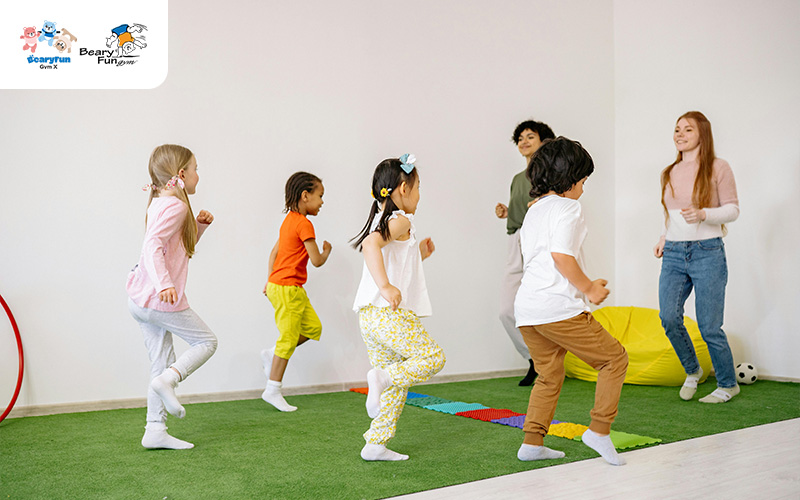
1. A Safe and Supportive Environment
One key advantage of preschool gyms is their design. With fully padded floors, soft mats, and child-safe equipment, children can explore climbing, balancing, and tumbling activities without the risk of injury. This sense of physical safety reduces hesitation and encourages exploration.
When children know they’re unlikely to get hurt—even if they lose balance or fall—it builds trust in their surroundings. This trust is the first step in reducing fear and building physical confidence.
2. Guidance Without Pressure
Trained instructors are vital in creating a nurturing, pressure-free environment. Rather than pushing children to perform or compete, coaches focus on encouragement, patience, and emotional support.
Every child is encouraged to try new activities at their own pace. This child-led approach ensures that exposure to heights remains positive and manageable. Through routine, repetition, and reassurance, children become familiar with the preschool gymnastics equipment and gradually reduce anxiety to take small, brave steps forward.
3. Targeted Activities That Gently Introduce Heights
Preschool gymnastics lesson plans are intentionally designed to introduce children to mild height challenges. Children can overcome the fear of heights in a gradual and engaging way:
- Crawling through low tunnels helps children gradually build tolerance for mild discomfort or uncertainty in unfamiliar settings. This activity also enhances their spatial awareness and confidence in navigating tight or enclosed spaces.
- Walking across low balance beams improves coordination. At the same time, it also gently exposes children to the sensation of being elevated.
- Rolling or climbing on wedge-shaped mats allows children to navigate inclines. It promotes strength, control, and familiarity with upward and downward movement.
These toddler confidence-building activities are disguised as mere fun. The truth is, they are powerful tools in helping children reframe their relationship with heights. Each small success, whether it’s climbing a step higher or balancing for a few seconds longer, reinforces their self-belief and reduces anxiety.
What Are Some Physical Benefits That Can Build Emotional Confidence?
When it comes to overcoming fear, physical progress and emotional growth go hand in hand. Each time a child successfully navigates a balance beam or climbs onto a mat, they experience a powerful message: “I can do this.”
These small but significant wins build self-esteem, reinforcing the belief that challenges can be conquered. Over time, this sense of achievement expands beyond the gym. It encourages children to take on more new tasks and manage anxieties in height-related activities, including safe climbing.
1. Gross Motor Skill Development
A good preschool gymnastics curriculum is curated to promote children’s gross motor skills development, including balance, coordination, and muscle control. With this improved motor control, children can respond to height-related challenges. When they feel physically steady and capable, their fear of falling diminishes. A child who once froze at the idea of stepping onto a raised platform may now walk confidently, supported by a body that feels in control.
2. Improved Body Awareness
Body awareness—also known as proprioception—is the ability to understand how your body moves in space. Through guided gym activities, children begin to judge distance, depth, and movement more accurately. This allows them to gauge where their feet land, how far to stretch, or how to recover their balance mid-motion.
When children know what their bodies are capable of, uncertainty gives way to confidence. Instead of hesitating near a low ledge or backing away from a short climb, they begin to engage with these challenges more willingly, trusting in their ability to move safely and effectively.
Ultimately, physical development prepares them to be more emotionally resilient, adaptable, and self-assured. This is the foundation for overcoming a fear of heights and embracing new experiences with courage.

Why Enrol in BearyFun Gym’s Basic Class
At BearyFun Gym, our basic class is thoughtfully crafted to meet toddlers where they are—physically, emotionally, and developmentally. Designed by early childhood experts, our gymnastics classes for kids are backed by child development principles. We deliver them in a way that feels like pure play to the child, but with measurable growth built into every session. In a safe, padded, and stimulating environment, children are encouraged to explore gentle height challenges and structured activities that nurture both movement and mindset.
Targeting Children Aged Between 18 Months and 3 Years Old
More than just cute first steps and playful tumbles, this early toddler phase opens a crucial window for physical, emotional, and neurological development. At this stage, children are beginning to explore their environment independently, but they still rely heavily on support and structure to feel secure.

Why This Period Matters
Between 18 months and 3 years of age, children experience rapid growth in motor coordination, spatial awareness, and emotional regulation. Introducing purposeful, movement-based challenges during this phase helps toddlers build the internal tools to assess risk, manage fear, and bounce back from small setbacks.
Core Benefits of Our Basic Classes:
- Overcome the fear of heights through progressive exposure to soft climbing and balancing tasks.
- Enhance gross motor skills through structured play like crawling, walking on beams, and rolling.
- Build body stability and coordination, improving posture and movement control.
- Develop core strength with gentle static stretches introduced in a fun, age-appropriate way.
Frequently Asked Questions
1. Is it normal for toddlers to be afraid of heights?
Yes, it’s completely normal. Toddlers are still developing their sense of balance and spatial awareness. A fear of heights often reflects their natural caution as they begin to explore the world more independently.
2. At what age do children typically outgrow their fear of heights?
Many children become more confident with heights between the ages of 3 and 5 as their motor skills, balance, and body awareness improve. However, regular exposure in a safe and encouraging environment. For instance, preschool gymnastics can help ease the fear earlier.
3. What if my child refuses to try climbing or balancing activities?
That’s okay! Every child develops at their own pace. Preschool gyms are designed to be non-pressurising. Instructors often guide children gently, offering alternative activities that build trust and allow gradual progress.
Conclusion
The fear of heights is a normal part of early development, but it doesn’t have to hinder your child’s development. With the right support and environment, even the most cautious toddlers can learn to face challenges with courage and curiosity.
Preschool gyms provide the perfect setting to help children overcome their fear of heights through safe, structured play. Early exposure to climbing, balancing, and navigating new heights helps build coordination, strength, emotional resilience, and self-belief.
At BearyFun Gym, we believe that movement is the foundation of all physical development. We also understand how every child deserves the chance to grow at their own pace. Our thoughtfully designed programmes use gymnastics-inspired activities to nurture essential movement skills in a fun, non-competitive, and supportive environment.
By starting early and supporting your child with the right tools, you’re helping them become braver, stronger, and more confident every day. Ready to help your little one take that first step? BearyFun Gym is here to guide the way.
Contact us to learn more.


